#homocore toronto
Text
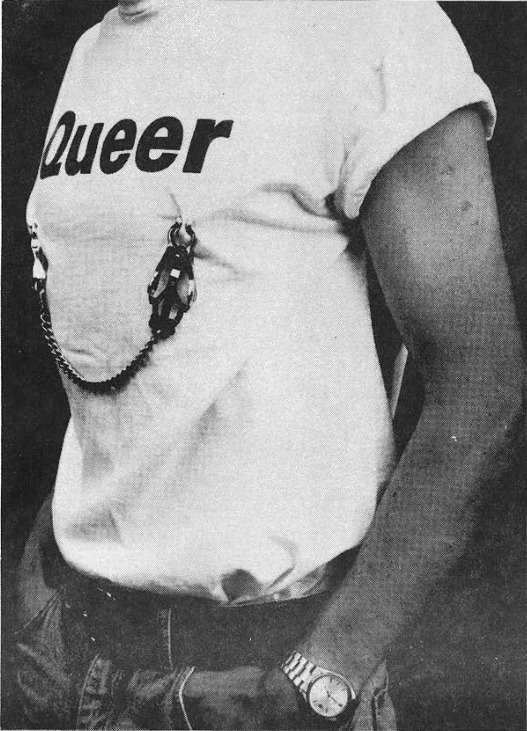


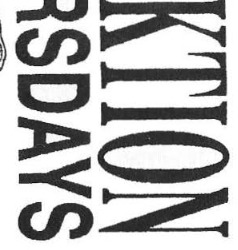
HOMOCORE TORONTO #2, 1993, NSFW
3K notes
·
View notes
Text
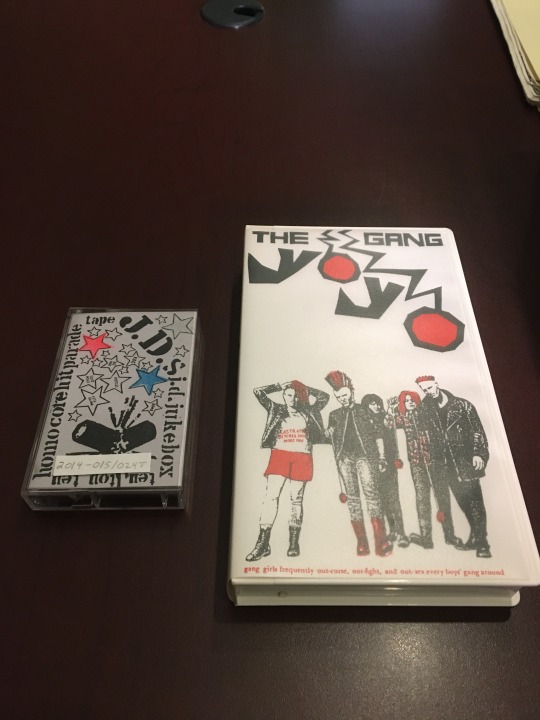
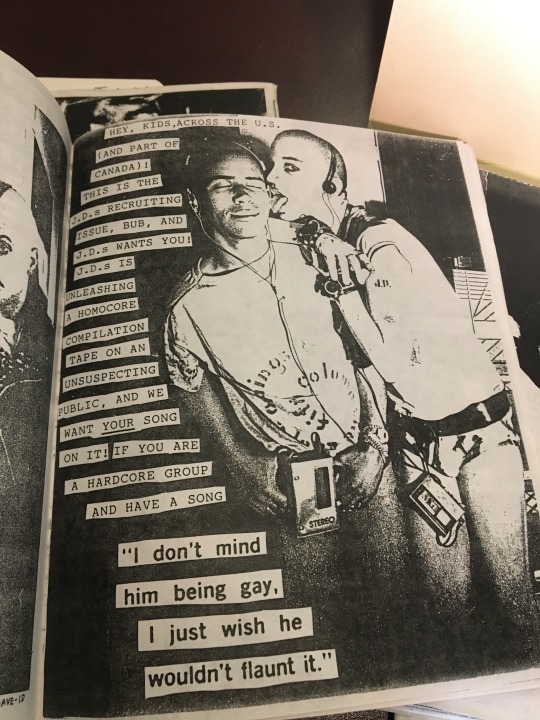

yesterday i went to the arquives (lgbt archive) in toronto and read issues of j.d.s, listened to the j.d.s' top ten homocore hit parade cassette, and watched the yo-yo gang directed by g.b. jones on vhs!
#i love canadian queercore#and i love physical media#and i love zines#and i love cassette tapes#and i love vhs tapes#queercore#arquives#bruce labruce#gb jones#jds zine
22 notes
·
View notes
Text

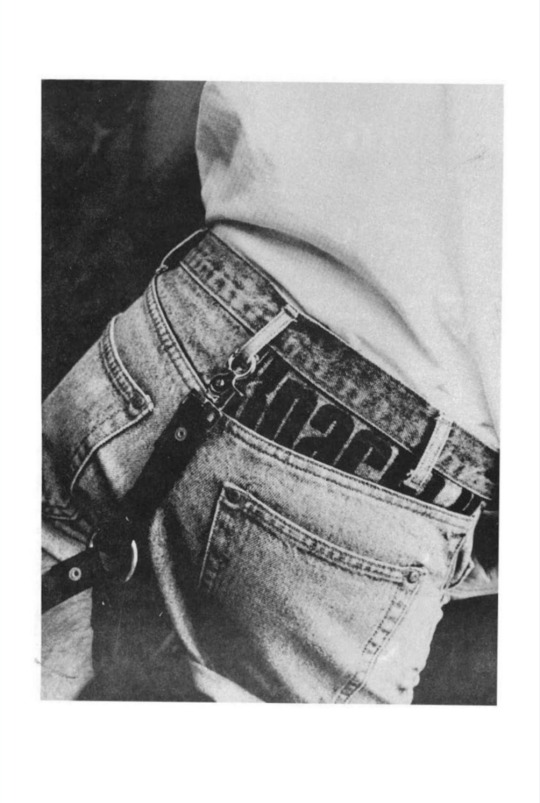
Pages from Homocore Toronto #2
1993, Edited and published by Alan O’Connor
Available to read here at the Queer Zine Archive Project site (somewhere I’d really recommend checking out for all sorts of queer content- not just zines!)
#homocore#queercore#queer zines#lgbt history#queer punk#queer history#lgbt+ history#lgbt zine#queer zine#f slur#d slur
66 notes
·
View notes
Text
REVISITING THE PERMISSION FACTORY Scott Treleaven (2015)
You’ll have to forgive a few extremely unsexy paragraphs so we can get down to figuring out the lifelong, tenuous romance between punk and gay culture: how it got started in the 70s, how it got revitalized in the 90s, and why this unique relationship persists. It’s the story of how gay culture rescued the first would-be punks from the sexual puritanism of their parents, and how punk would later resuscitate the fury of a devastated gay scene. When I first got into punk music as a kid I found that I connected with a sensibility that seemed to exist nowhere else. What I could only later describe as “Weimar-esque,” punk seemed to have awareness not only of how sex could be liberating and daring, but how it could also be used to *entertain* without being sapped of its vitality. Whatever can be said about punk’s stance against normalcy and capitalism, punks knew the importance of putting on a show; it didn’t have to be a good show, it didn’t have to be a long show, but punk always promised that there’d be something genuine to experience. The fact that some twenty years on it would become relevant again, in a regenerated form as “queercore”, is a testament to punk’s original intent. And once again this reincarnation would come partly as vaudeville, and partly as social hammer.
Of all the ‘origin of the species’ stories about how and where punk got started, who its progenitors were and what historical and cultural factors came together to birth it, Jeff Nuttal’s appraisal in BOMB CULTURE (1968) rings most true for me. Written almost a decade before punk existed, Nuttall surmised that the somber and shell-shocked post-World War II generation would also have to deal with the profound moral schizophrenia brought on by a moment that annihilated the reassuring binary simplicity of ‘good guys versus bad guys,’ forever. The men and women raising children in the late sixties in the UK and the US, the children that would eventually become the first “punks,” must have had found it hard to countenance that the good guys who liberated Europe had gone on to commit the unspeakable atrocity of dropping an atomic bomb on Hiroshima. Not only did it mean that the shadow of nuclear war hung over the world’s future from now on, but it begged the mostly unspoken question of how one raises a child with any kind of moral assurance when the supposed good guys were capable of the very atrocities they had fought against. Unlike the Bright Young People who emerged as a sort of upper-class, upbeat and insolent post-WWI phenomenon, the pervading air of nihilism and punk’s working class roots had more in common with the clownish despair found in Dada. The closeness of the US/UK alliance might also explain how mutual culpability created a climate that lead to punk’s simultaneous emergence in both countries. Always in the background, the same subliminal refrain, that the dominant culture no longer held moral authority.
The staggering austerity that punk emerged from made it seem like there literally was no future to be had. When I hear tales of kids playing in the bombed out ruins of an empire I think how it must’ve made the edifices of society seem as flimsy and impermanent as they, in fact, are. The only thing you could be sure of was that your young body was alive and filled with a kind of vitality that wasn’t mirrored in the landscape. Suspicion of tradition gave way to a thirst for what was outside, what was verboten. What the parents rejected the kids embraced. Reggae was alien, exciting and new; the Nazi paraphernalia that terrified their elders could be wielded partly for shock value but also to disgrace its symbolic power; and there was also a more pronounced cognizance that underneath the New York Dolls’ and Bowie’s slap was a frank acknowledgement of the wild frontier of gay culture and its influence on style. Along with the draggish maquillage, the bondage gear and the outright porn, what punk found thrilling in the burgeoning gay scene was its frank embrace of fringe and coded styles, its penchant for hidden venues, its gender non-conformity, and the inherent power in outsider camaraderie. After all, “punk” meant “gay” before punk meant punk. The queered sexiness that would become intrinsic to punk had the dual purpose of titillating the uninitiated while simultaneously ridiculing the uptight behind-the-plastic-curtains realm to which sex (or any arousing image outside of sanctioned smut and/or artwork) had been relegated by older generations. Punks were all about giving each other permission to flaunt, demystify and explore own their sexuality.
Eventually, after a particularly cold-blooded breed of Conservatism (perhaps there is no other kind) took hold at the end of the 70s, the virulence of its free market spirit had the effect of turning punk signifiers into just another load of feel good shopping experiences. Stock slogans, mohawks, safety pins and leather jackets became a uniform; anathema to the very things punk was initially about. While punk was defanged, an even more horrifying extermination of subcultural potential was taking place as the sexual libertinism and freedom that characterized the gay scene was ravaged by AIDS. Whereas the radioactivity from Hiroshima eventually dissipated, and the West somehow got back to convincing itself of its own decency, the AIDS epidemic was just getting started and the banner of morality was callously plied to create an exponential body count, and effectively ensuring a plague that could never be contained. By the early 90s the gay scene had gone back to adopting an attitude similar to the “clone” mentality of the late 70s; originally used as a way of signifying sexual difference and availability, the gay scene had now become cautious, conformist and grim as AIDS killed off most of the renegades and sexual astronauts. After approximately 500,000 cases of AIDS and 300,000 deaths in the US alone were reported by the mid-90s, gay culture was reeling and understandably desperate for some kind of homogeneity to patch together what was left. It was from this gloomy fray that queercore first emerged.
As punk had once turned to queer culture for its social-sexual strategies, now it was returning the favor. The blinkered gay and lesbian mainstream in the mid-90s felt neither inclusive nor progressive, or even particularly political, suffering as it was from what can only be called battle fatigue. Under siege for so long, the scene seemed to want to return to some kind of clement version of a pre-AIDS heyday where everyone could listen to mediocre dance music in the company of others who wanted to conform to the new gay normal. If the world was fair, the likes of Queer Nation, Outrage and Gran Fury would’ve thrived, but there was less room now for the libertine weirdos and troublemakers who might (or might not) have caused all of the chaos in the first place. Eventually two Toronto-based punks, G.B. Jones and Bruce LaBruce, would change everything by launching an incendiary campaign through zines, music and manifestoes, to call out the gays on their conservatism and to make the supposedly open-minded punks put their inclusivity to the test. Following their lead, queercore bands, zines and record labels – like Matt Wobensmith’s Outpunk – flourished. For me personally, as a twenty-year old punk recently transplanted back in Toronto in 1993 after a year of living hand-to-mouth in London, discovering that I could reconcile my music, my politics and my sexuality was a revelation. Already ideologically hopped-up on publications like RE:SEARCH, RAPID EYE and HOMOCULT, I’d also had a fortuitous meeting with queer saint Derek Jarman shortly before my return who clinched for me the idea that there was more to one’s sexuality than simply who you fucked. Jarman’s idea of queerness was that it was a blessing of sorts, a radiant kind of permission. It reinforced for me what I’d always felt: that being queer meant that you could slough off a past, an ideology and a trajectory, that's not yours to inherit and keep on forging paths that are as yet unimagined. And if that wasn’t punk, I didn’t know what was.
Graduating from art school in 1996, and with G.B. Jones’ help, I shot the world’s first queer punk documentary. More of a polemic than a who’s-who, QUEERCORE: A PUNK-U-MENTARY was an attempt to unify some of the politics and positions of the company of outcasts I was keeping. Combining these ideas with some stark pseudo-military aesthetics copped from postpunk bands like Psychic TV and New Model Army, I also started publishing my own zine, THIS IS THE SALiVATION ARMY. Rejecting salvation as a nebulous, ludicrous concept, *salivation* was where it was at; always on the tip of your tongue, something your body knows. And in the wake of the full on body-terror that followed AIDS, this kind of fluidic moniker was about more than just spit. Branding itself as a the mouthpiece of a full-fledged “queer pagan punk” movement with hundreds of members and everybody fucking each other, it didn’t seem useful, or poetically true, to tell readers that in reality it was just me with a gluestick, alone at 3am in an all-night photocopy shop. Another lesson learned from punk: print the legend. Aside from the hyperbole, the zine distinguished itself by trying to be an honest platform to discuss and celebrate sexuality in all its forms, and to this day it’s a point of pride to know that my readership wasn’t solely made up of horny homocore boys, but an equal amount of women, bi and straight readers, too.
Eventually the zine spawned a film of the same name in 2002 that would try to keep the myths alive alongside the truth. The fact that the zine and the film still get unearthed says something, to me at least, about its view of sexuality as something innately powerful, and the punk ethos at its core still gives the go-ahead to explore in the company of like-minded others; being part of an ongoing, swelling history is always better than being part of something unique. When punk first reared its head in the 70s, decrying sex as squelchy and boring was a genius way of disarming the shame-makers, the rockers and the doting hippies, showing a preference instead for anger and action over getting your rocks off and calling it a weekend. In the 90s however the slogan had shifted to take aim at the puritans and fear-mongers with a distinctly feminist pitch. The patches on people’s jackets were daubed with slogans like: You Say Don’t Fuck, We Say Fuck You!, Silence = Death, and Not Gay As In Happy, But Queer As In Fuck You! On the heels of this declaration that queers weren’t the filthy creatures that the religious zealots and right wing would have you believe, another reinvigoration of sexual awareness came in the form of a wave of punk-made porn. It’s almost impossible to imagine now, but in the pre-selfie, pre-internet world, occupying pornography was a radical act. Like industrial musician and performance artist Cosey Fanni Tutti’s astutely aware ownership of her participation in pornography – usurping the male-made-for-male-gaze structure – the queercore scene wrestled its bodies away from the overly muscled uniformity of the Aryan sideshow freaks that populated gay porn and made images of their own. Like Warholian superstars, Jones’ and LaBruce’s zines and films launched a new blue generation and everyone, myself included, loaned their time and their bodies to one another in the pursuit of a new kind of radicalism. Suddenly you weren’t jerking off to the too perfect torsos in mainstream porn, instead you could find insanely erotic homegrown smut to get off on that also served the purpose of smashing the stereotypes purveyed by the other mags. The empowerment had positive effects on the models, too. Starring in a couple of centerfolds and films, I found that the lowly view I’d held of my weedy twenty-year old body started to vanish. Better yet, as I got behind the camera I learned to make other models snap out of their narrow views of what turned people on as we added our own brands of eroticism to the collective pool.
The notion that punk was anti-sex, entirely cynical or entirely nihilistic is overplayed. There would’ve been no bands, no shows, no pageantry and no studied provocation if that were true. Now that gay culture has become obsessed with the push for “equality” an ugly, overwhelming sense of genteel propriety has come along with it. The church and the army – the last places on earth a punk or a queer should be – are the mindboggling territories being fought for. When I think about the first time I saw Pete Shelley mincing around in the video for ‘Homosapien,’ even at the tender age of eight I felt that the elegant futuristic world he occupied was going to be mine too, someday, not the weddings and wars that were the destiny of my other little friends. As the 2000s kicked in, my hometown Toronto was a hotbed of queercore activity well past the time when most of the early bands had hung up their guitars and the zines had folded. The late, great artist impressario Will Munro organized a vibrant scene there that was dedicated to the idea that the sexual vitality of the queer scene aligned with the restless utopic cravings of punk could still come together to create something *other*, something *better*. The entire planet is currently groaning under the weight of conservative corporatism, and those thinly veiled fascists are floating the idea that there is no other way but theirs. The spirit of punk, if it truly did anything in the past, and if it can do anything now, is to keep kicking the can further down the road; to say, “This is bullshit and it’s not enough, we can do better. And if you can’t make it better we’ll smash it up and start over.” Sex, punk-sex if you will, can remind us of where that desire originates. It’s in our bodies, it’s innate and it says something more to us about our human place in the world than simply being on a conveyer belt through a shopping-mall-cum-torture-chamber.
– originally published in ‘SHOWBOAT: PUNK/SEX/BODIES’ (2016), edited by Toby Mott http://bit.ly/2twFApe
8 notes
·
View notes
Photo

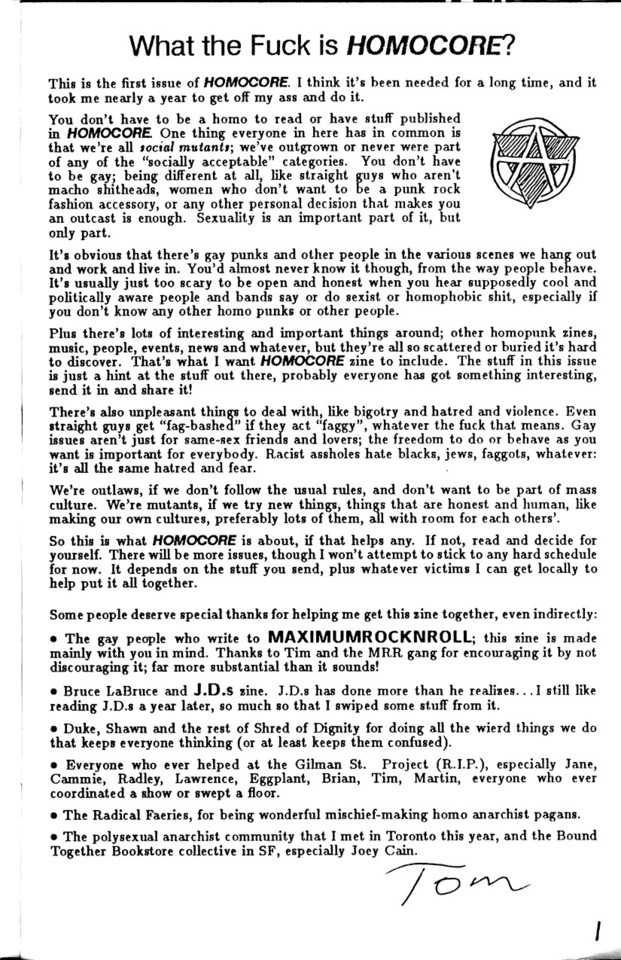
Homocore #1, 1988
-Pictured is the first issue’s cover/first page
-Edited by Tom Jennings and Deke Motif Nihilson
-Named by Bruce La Bruce and G.B. Jones (from JDs - JDs means Juvenile Delinquents; a zine in Toronto)
-Made from the distaste for separateness (gay community vs. world) x anarchist ideals
-Made for “social mutants” -- do not need to be gay in order to read/contribute/relate to Homocore
12 notes
·
View notes
Photo

I was all smiles through this amazing documentary directed by #AngeliqueBosio about #brucelabruce's films. A+++++ 💯#gusvansant #johnwaters #thelollipopgeneration #kurtcobain #jds #queerzines #queerartist #queerfilmmaker #harmonykorine #vaginaldavis #jacksargeant #richardkern #glennbelverio #homocore #queercore #queerpunk #rickcastro #skinheads #rupertgoldsworthy #ernesthardy #brucebenderson #kembrapfahler #toronto #boreonto #jürgenbrüning #sussanesachsse #xxxgays #jeycrisfar #javierperes #danielnicoletta #artporn #pornopoly
#rupertgoldsworthy#brucelabruce#queercore#brucebenderson#gusvansant#thelollipopgeneration#sussanesachsse#pornopoly#angeliquebosio#ernesthardy#rickcastro#skinheads#jeycrisfar#queerartist#vaginaldavis#kembrapfahler#jds#queerfilmmaker#jacksargeant#harmonykorine#javierperes#queerzines#jürgenbrüning#glennbelverio#toronto#johnwaters#artporn#boreonto#xxxgays#homocore
2 notes
·
View notes
Photo
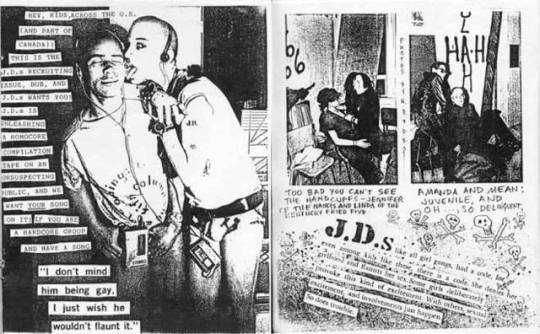



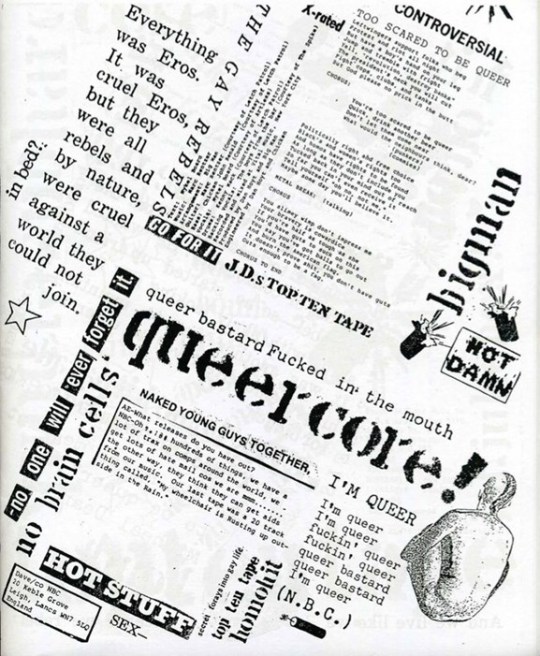
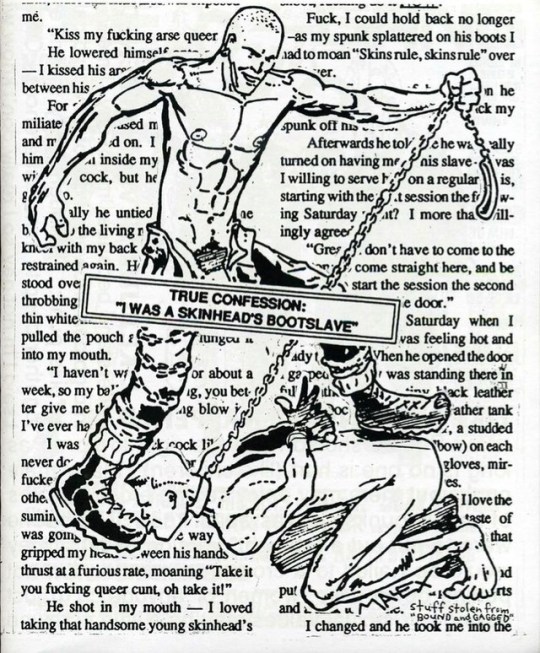
Zine: J.D.s Date: 1989 Toronto,Canada
J.D.s was a queer punk zine founded in Toronto by G.B. Jones and co-published with Bruce LaBruce.
" J.D.s is seen by many to be the catalyst that pushed the queercore scene into existence", writes Amy Spencer in DIY: The Rise Of Lo-Fi Culture. J.D.s ran from 1985 to 1991, during which time eight issues were released. A cut and paste, photocopied zine, it proved influential.
After the release of the first few issues, the editors wrote a manifesto entitled "Don't Be Gay", which was featured in Maximum Rock 'N' Roll. According to Amy Spencer, "The article appeared in February 1989 and simultaneously attacked both punk and gay subcultures. Following their article, a queer punk culture did begin to emerge."
queer punk, homocore, gay bill of rights, sex gang, Fifth Column, The Dicks, A.S.F. , Sex Pistols, Jimboy X, fiction, cock, Anonymous Boy, Henry Rollins, Mean Jean : queer punk, homocore, punk, tattoos, nudity , Tom's Girls, sex, A.S.F. , cock
0 notes